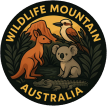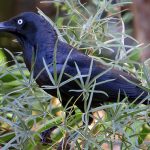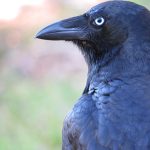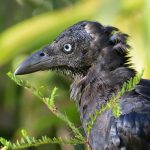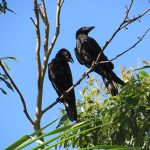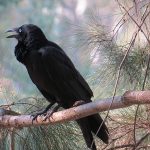FOREST RAVEN
The Forest Raven
The Forest Raven is one of Australia’s most striking and mysterious corvids – glossy black, intelligent and full of personality. It’s often confused with “crows”, but it has its own distinct story, especially in Tasmania and the cooler, wetter parts of south‑eastern Australia.
Overview
- Scientific name:
Corvus tasmanicus - Family: Corvidae (crows, ravens and jays)
- Distribution:
- Widespread in Tasmania (common, including coastal areas)
- Also in southern Victoria, south‑eastern South Australia, New South Wales coastal ranges and parts of King and Flinders Islands
- Habitats:
- Wet and dry forests
- Farmland and pasture
- Coastal heath, beaches and cliffs
- Edges of towns and rural properties
You’re most likely to hear them before you see them: a deep, resonant call rolling across valleys or along a wind-swept coastline.
What a Forest Raven Looks Like
Size and Build
- Body length: ~50–55 cm from bill to tail
- Wingspan: ~90–110 cm
- Weight: ~650–750 g (varies with sex and region)
- Shape:
- Solid, robust body
- Heavy bill, thick from base to tip
- Long, broad wings
- Wedge‑shaped tail when spread in flight
Plumage and Colour
Forest Ravens are entirely black, but in good light they are anything but dull:
- Feathers: glossy black with a purplish or bluish sheen
- Throat feathers: slightly shaggy and longer, especially when calling
- Eyes:
- Young birds: dark brown
- Adults: pale whitish to bluish-white eyes – very striking at close range
- Bill and legs: black
Imagine a bird that seems almost absorbent of light in deep shade, then suddenly flashes with a subtle iridescence when the sun breaks through the canopy.
Longevity (Lifespan)
- Wild lifespan: commonly 10–15 years
- Some individuals may reach 20+ years if they survive the dangers of their early life.
- In captivity: corvids can sometimes live over 20 years, thanks to regular food and lack of predators, though there is limited specific data for Forest Ravens.
Like many intelligent birds, they invest in long-term pair bonds and complex social lives, which makes living longer an advantage.
Breeding and Family Life
Breeding Season
- In Tasmania and much of their range:
- Main breeding season: August to December (late winter to early summer)
- Timing can shift slightly with local climate and food availability.
Pair Bonding and Territory
- Forest Ravens usually form long-term monogamous pairs.
- Pairs defend a territory year-round, but they are most vocal and defensive in the breeding season.
- Younger, non-breeding birds may form loose flocks and roam more widely.
Nests
- Nest type: Large, bulky bowl-shaped structure
- Location:
- High in trees (often near the top of tall eucalypts)
- Occasionally on cliff ledges or other elevated, secure spots
- Materials:
- Sticks as the main framework
- Lined with softer materials such as grass, bark, wool, and sometimes fur or other fibres
- The nest interior is surprisingly soft and well-insulated compared to its rough outer shell.
Eggs and Young
- Clutch size: usually 3–5 eggs
- Eggs:
- Greenish or bluish with darker blotches and speckles
- Incubation:
- About 18–21 days
- Mainly done by the female, while the male brings food and stands guard
- Nestling period: chicks remain in the nest for about 5–6 weeks
- After leaving the nest, young ravens stay with their parents for several months, learning where to feed, what to avoid, and how to survive.
You’ll often see family groups – noisy youngsters trailing after the adults, begging with fluttering wings and high-pitched calls.
How to Tell a Forest Raven from a Crow
Australia has three ravens and two crows on the mainland, plus the Forest Raven. Distinguishing them can be tricky, but Forest Ravens have some reliable features, especially compared with crows.
1. Location
As a quick guide:
- Forest Raven:
- Common in Tasmania – if it’s there and looks like a crow/raven, it’s almost certainly a Forest Raven.
- Also in cooler, forested and coastal areas of south‑eastern mainland Australia.
- If you’re in tropical or arid inland regions, you’re more likely seeing a Little Crow or Torresian Crow, not a Forest Raven.
2. Size and Build
Compared with crows:
- Forest Ravens are generally larger and more robust.
- They have a thicker, more powerful bill.
- The throat feathers can look shaggier when they call, though not as extreme as the Australian Raven’s “beard” in some regions.
3. Eye Colour (Adults)
- Forest Raven adults: very pale, whitish to bluish-white eyes
- Crows (e.g. Torresian Crow, Little Crow): usually brown eyes, not pale.
If you can see a pale eye clearly in a mature bird in Tasmania or a cool coastal forest, that’s a strong clue it’s a Forest Raven or one of the other ravens, not a crow.
4. Call (Voice)
The voice is one of the best field clues.
- Forest Raven call:
- Deep, resonant, somewhat drawn-out “ark… ark… ark” or “korrk-korrk”
- Often sounds hoarse and rolling, with a slightly “hollow” quality
- Calls can descend in pitch and may have a mournful, echoing tone in forested valleys.
- Torresian Crow (for example):
- Sharper, more clipped “karr, karr, karr”
- Generally less deep and less rolling than a Forest Raven.
Experienced birders often identify them almost purely by call.
5. Habitat Use
While both crows and ravens are adaptable, Forest Ravens have preferences:
- More common in:
- Forested areas
- Coastal cliffs and dunes
- Pasture and farmland near forest
- Crows (especially Torresian Crow) are very common in:
- Suburban and urban areas
- Open farmland and dry inland regions
Distinguishing Forest Raven from Other Australian Ravens
Within ravens, the differences are subtle but interesting:
| Species | Main Range | Key Clues |
|---|---|---|
| Forest Raven | Tasmania, SE Australia | Coastal/forest; deep hoarse call; robust |
| Australian Raven | Eastern & southern mainland | Longer throat “beard”; distinct drawn-out call |
| Little Raven | Southern inland & SE | Smaller; more nasal, shorter calls |
| Little Crow | Arid inland | Very small for a corvid; fine bill |
In Tasmania, you don’t have to worry: the crow-like bird you see is almost always the Forest Raven.
Diet and Feeding Behaviour
Forest Ravens are opportunistic omnivores with a varied menu:
- Animal matter:
- Insects, grubs, beetles
- Small mammals, reptiles and amphibians (when they can catch them)
- Bird eggs and nestlings (they will raid nests)
- Carrion – dead animals, including roadkill
- Plant matter:
- Seeds and grains
- Fruits and berries
- Human-related food:
- Rubbish tips, picnic scraps, fish offal near boat ramps
- Spilled grain in paddocks
They use their strong bill and sharp eyes to explore logs, dig lightly into soil, and tear open carcasses. Around farms, they may be seen following tractors, grabbing exposed insects and grubs.
Behaviour and Intelligence
Corvids, including the Forest Raven, are among the most intelligent birds.
Social Behaviour
- Often seen in pairs or family groups in breeding season.
- In non-breeding times, younger birds may form flocks, particularly around rich food sources such as coastal fish-cleaning areas, rubbish tips, or recently ploughed fields.
Problem-Solving and Memory
While specific cognitive studies on Forest Ravens are limited, corvid behaviour in general suggests:
- They can remember good feeding spots, returning at the right time (for instance, after tides or seasonal events).
- They may cache food (hide it) and return to it later.
- They quickly learn to associate human activity (like fishing or farming) with food opportunities.
If you spend time watching a group of Forest Ravens, you can see them testing objects, watching one another, and sometimes clearly outsmarting other scavengers.
Interesting Facts
1. A Coastal Specialist (in Many Areas)
Forest Ravens are particularly common along Tasmania’s coastline and some south‑eastern mainland coasts:
- They feed on:
- Washed-up fish and invertebrates
- Shellfish and crabs (including scavenged remains)
- Food scraps around fishing villages and campgrounds
- Their deep calls mix with the sound of waves and wind, creating that classic “wild coast” atmosphere.
2. Important Scavengers
By consuming carrion (dead animals), Forest Ravens:
- Help clean the environment of carcasses
- Reduce the spread of certain diseases and parasites
- Recycle nutrients back into the ecosystem
They are part of the natural “clean-up crew” alongside other scavengers.
3. Complex Communication
Their calls are not just random noise. They use:
- Different call patterns for:
- Alarm signals
- Territory defence
- Contact between mates or family members
- Subtle changes in pitch, rhythm, and intensity that other ravens clearly understand, even if we do not.
4. Adaptable but Vulnerable to Persecution
Historically, ravens have sometimes been persecuted:
- Farmers have occasionally blamed them for killing lambs. In many cases, ravens are more often scavenging on already dead or very weak animals rather than killing healthy ones.
- Despite this, the Forest Raven remains common and widespread in its core range, thanks to its adaptability.
Conservation Status
- Currently listed as Least Concern (not considered threatened) at a broad scale.
- However, they rely on:
- Access to nesting trees
- Sufficient food resources
- Safe breeding areas free from excessive disturbance
Local population pressures can occur where large old trees are removed, extensive habitat clearing takes place, or where persecution is intense.
Encouraging coexistence – understanding their ecological role and avoiding unnecessary harm – helps maintain healthy populations.
How You Can Observe Forest Ravens
If you want to watch them more closely:
- Visit coastal areas or forest edges in Tasmania or south‑eastern mainland Australia, especially in the morning or late afternoon.
- Listen first – tune in to that deep, hoarse call rolling through the air.
- Watch with binoculars:
- Look for pale eyes in adults
- Note their confident, steady flight with broad wings and a wedge‑shaped tail
- Observe their interactions:
- How they approach food
- How they watch each other
- How they respond to raptors or humans
The more you watch them, the easier it becomes to tell them apart from crows and even from other ravens.
In Summary
- The Forest Raven is a large, robust, glossy black corvid of Tasmania and south‑eastern Australia.
- It can live 10–15 years or more, forming long-term pair bonds and defending territories.
- It breeds in large stick nests high in trees, raising broods of 3–5 chicks.
- It differs from crows by its:
- Range (especially its dominance in Tasmania)
- Larger size and heavier bill
- Pale eyes in adults
- Deep, hoarse, rolling call
- Intelligent, adaptable and important as a scavenger, it plays a valuable role in Australian ecosystems.
